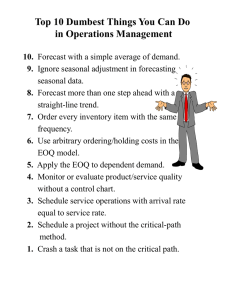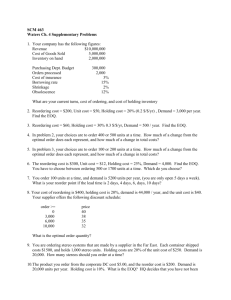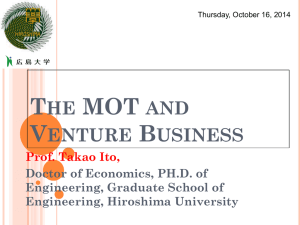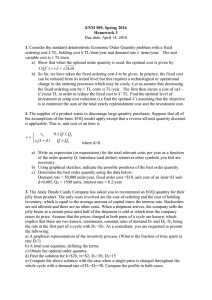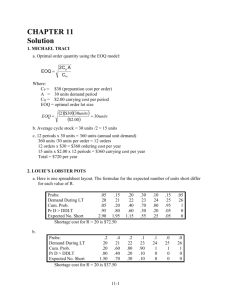CHAPTER 16
advertisement
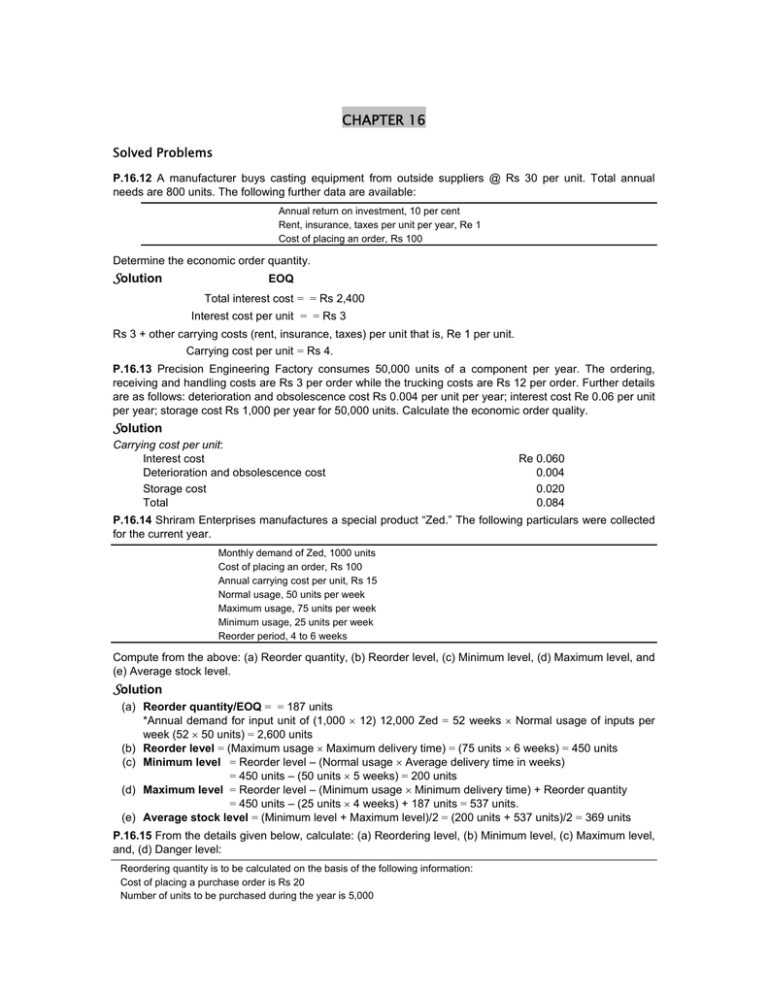
CHAPTER 16 Solved Problems P.16.12 A manufacturer buys casting equipment from outside suppliers @ Rs 30 per unit. Total annual needs are 800 units. The following further data are available: Annual return on investment, 10 per cent Rent, insurance, taxes per unit per year, Re 1 Cost of placing an order, Rs 100 Determine the economic order quantity. Solution EOQ Total interest cost = = Rs 2,400 Interest cost per unit = = Rs 3 Rs 3 + other carrying costs (rent, insurance, taxes) per unit that is, Re 1 per unit. Carrying cost per unit = Rs 4. P.16.13 Precision Engineering Factory consumes 50,000 units of a component per year. The ordering, receiving and handling costs are Rs 3 per order while the trucking costs are Rs 12 per order. Further details are as follows: deterioration and obsolescence cost Rs 0.004 per unit per year; interest cost Re 0.06 per unit per year; storage cost Rs 1,000 per year for 50,000 units. Calculate the economic order quality. Solution Carrying cost per unit: Interest cost Deterioration and obsolescence cost Storage cost Total Re 0.060 0.004 0.020 0.084 P.16.14 Shriram Enterprises manufactures a special product “Zed.” The following particulars were collected for the current year. Monthly demand of Zed, 1000 units Cost of placing an order, Rs 100 Annual carrying cost per unit, Rs 15 Normal usage, 50 units per week Maximum usage, 75 units per week Minimum usage, 25 units per week Reorder period, 4 to 6 weeks Compute from the above: (a) Reorder quantity, (b) Reorder level, (c) Minimum level, (d) Maximum level, and (e) Average stock level. Solution (a) Reorder quantity/EOQ = = 187 units *Annual demand for input unit of (1,000 × 12) 12,000 Zed = 52 weeks × Normal usage of inputs per week (52 × 50 units) = 2,600 units (b) Reorder level = (Maximum usage × Maximum delivery time) = (75 units × 6 weeks) = 450 units (c) Minimum level = Reorder level – (Normal usage × Average delivery time in weeks) = 450 units – (50 units × 5 weeks) = 200 units (d) Maximum level = Reorder level – (Minimum usage × Minimum delivery time) + Reorder quantity = 450 units – (25 units × 4 weeks) + 187 units = 537 units. (e) Average stock level = (Minimum level + Maximum level)/2 = (200 units + 537 units)/2 = 369 units P.16.15 From the details given below, calculate: (a) Reordering level, (b) Minimum level, (c) Maximum level, and, (d) Danger level: Reordering quantity is to be calculated on the basis of the following information: Cost of placing a purchase order is Rs 20 Number of units to be purchased during the year is 5,000 Purchase price per unit inclusive of transportation cost is Rs 50. Annual cost of storage per unit is Rs 5. Details of lead time: Average, 10 days; Maximum, 15 days; Minimum, 6 days. For emergency purchases, 4 days. Rate of consumption: Average: 15 units per day; Maximum: 20 units per day. Solution (a) Reordering level = Maximum usage × Maximum delivery time = 20 units × 15 days = 300 units (b) Minimum level = Reorder level – (Normal usage × Average delivery time in days) = 300 units – (15 units × 10 days) = 150 units (c) Maximum level = Reorder level – (Minimum usage × Minimum delivery time) + Reorder quantity = 300 units – (15 × 4 days) + 200 units* = 440 units. *Reorder quantity = = 200 units (d) Danger level = 15 units per day × Emergency purchase for 4 days = 60 units P.16.16 The Complete Gardener is deciding on the economic order quantity for two brands of lawn fertilizer: Super Grow and Nature’s Own. The following information is collected: Particulars Fertilizer Annual demand Relevant ordering cost per purchase order Annual relevant carrying cost per bag Super Grow Nature’s Own 2,000 Bags Rs 1,200 480 1,280 Bags Rs 1,400 560 Required: (i) Compute EOQ for Super Grow and Nature’s Own. (ii) For the EOQ, what is the sum of the total annual relevant ordering costs and total annual relevant carrying costs for Super Grow and Nature’s Own? (iii) For the EOQ, compute the number of deliveries per year for Super Grow and Nature’s Own. Solution (i) EOQ = = 100 bags (Super Grow) = = 80 bags (Nature’s Own) (ii) and (iii) Statement showing total relevant costs for Super Grow and Nature’s Own Fertilizer Particulars Super Grow Annual demand (bags) EOQ (bags) Number of orders/deliveries Multiplied by ordering cost per order (a) Total ordering cost Average inventory (1/2 × EOQ) of bags Multiplied by carrying cost per bag (b) Total carrying cost (c) Total cost (a) + (b) 2,000 100 20 Rs 1,200 24,000 50 480 24,000 48,000 Nature’s Own 1,280 80 16 Rs 1,400 22,400 40 560 22,400 44,800 P.16.17 The following details are available in respect of a firm: Annual requirement of inventory, 40,000 units Cost per unit (other than carrying and ordering cost), Rs 16 Carrying costs are likely to be 15 per cent per year Cost of placing order, Rs 480 per order Determine the economic order quantity. Solution EOQ C = Rs 16 × 0.15 = Rs 2.40 P.16.18 Good Luck Company estimates its carrying cost at 15 per cent and its ordering cost at Rs 9 per order. The estimated annual requirement is 38,000 units at a price of Rs 4 per unit. What is the most economical number of units to order and how often will an order need to be placed? Solution (i) (ii) Time after which an order is to be placed is given by the following formula (in days): Working Notes Total carrying cost = 38,000 units × Rs 4 × 15/100 = Rs 22,800 Carrying cost per unit = Rs 22,800/38,000 = Re 0.60 P.16.19 A customer has been ordering 5,000 special design metal columns at the rate of 1,000 per order during the past year. The production cost is Rs 12 a unit – Rs 8 for materials and labour and Rs 4 for overheads (fixed cost). It costs Rs 1,500 to set up for one run of 1,000 columns, and inventory carrying cost is 20 per cent. Since this customer may buy at least 5,000 columns this year, the company would like to avoid making five different production runs. Find the most economic production run. Solution Economic production run is given by the formula of EOQ in which B is setting up costs for one production run in place of buying cost per order. Accordingly, economic production run P.16.20 PQR Tubes Ltd are the manufacturers of picture tubes for T.V. The following are the details of their operations during the current financial year. Ordering cost (per order) Inventory carrying cost (per annum) Cost of tubes (per tube) Normal usage (tubes per week) Minimum usage (tubes per week) Maximum usage (tubes per week) Lead time to supply (weeks) Rs 100 20% Rs 500 100 50 200 6–8 Required: (i) Economic order quantity. If the supplier is willing to supply quarterly 1,500 units at a discount of 5 per cent, is it worth accepting? (ii) Re-order level (iii) Maximum level of stock (iv) Minimum level of stock Solution (i) EOQ = = 101.98 or 102 units A = 100 tubes per week × 52 weeks = 5,200 units C = Rs 500 per tube × 0.2 = Rs 100 per unit per year (b) Statement showing comparative total cost when order is placed on EOQ basis and when it is placed on quarterly basis, (supplying 1,500 units at 5 per cent discount) Particulars 1. 2. 3. 4. 5. 6. 7. 8. 9. 10. 11. Annual requirement (units) Order size (in units) Number of order (1 ÷ 2) Cost per order Total ordering costs (3 × 4) Cost per unit (tube) Cost of tubes (1 × 6) Average inventory (2/2) (units) Carrying cost per unit per annum Total carrying cost (8 × 9) Total cost (5 + 7 + 10) When order is placed on EOQ basis 1,500 units 5,200 102 50.98 Rs 100 5,098 500 26,00,000 51 100 5,100 26,10,198 5,200 1,500 3.47 Rs 100 347 475 24,70,000 750 95 71,250 25,41,597 Since total costs are lower when discounts are offered, it is worth accepting to place order of 1,500 units on quarterly basis. (ii) Re-order level Maximum ordering period (in weeks) × Maximum usage per week = 8 weeks × 200 tubes = 1,600 tubes (ii) Maximum level of stock Re-order level + Re-order quantity – (Minimum usage in weeks × Minimum lead time in weeks) = 1,600 tubes + 102 tubes – (50 tubes × 6 weeks) = 1,702 tubes – 300 tubes = 1402 tubes (iv) Minimum level of stock Re-order level – (Normal usage × Average lead time) = 1,600 tubes – (100 tubes × 7 weeks) = 900 tubes Review Questions 16.12 A firm’s annual requirement of inventory is 30,000 units. The acquisition costs amount to Rs 150 per order. The carrying costs are likely to be Rs 1.20 per unit per year. Assume the following order sizes: (i) 30,000 units (ii) 15,000 units (iii) 6,000 units (iv) 3,000 units (v) 1,500 units (vi) 750 units Determine (a) order cost, (b) carrying cost, (c) average inventory, (d) economic order quantity. 16.13 Product Y is sold in packages of 12 units for Rs 20 per package. After a number of years, it has been determined that the demand for product Y is at a constant rate of 2,000 packages per month. The cost price per package of the selling company is Rs 10. The company requires a three day lead time from date of order to date of delivery. The ordering cost is Rs 1.20 per order and the carrying cost is 10 per cent per annum. You are required to calculate the following: (a) The EOQ. (b) The number or orders needed per year. 16.14 (a) From the following information, determine EOQ: (i) Per month consumption: 75 units. (ii) List price per unit: Rs 4. (iii) Trade discount: 25 per cent from the list price. (iv) Per order cost: Rs 10. (v) Carrying cost: Re 0.20 per unit. (vi) The usage is assumed to be uniform throughout the year. (b) Determine the value per order. Answers 16.12 (a) Ordering cost Rs 150 (i), Rs 300 (ii), Rs 750 (iii), Rs 1,500 (iv), Rs 3,000 (v), Rs 6,000. (b) Carrying cost Rs 18,000 (i), Rs 9,000 (ii), Rs 3,600 (iii), Rs 1,800, (iv), Rs 900 (v), Rs 450. (c) 15,000 (i), 7,500 (ii), 3,000 (iii), 1,500 (iv), 750 (v), 375. (d) EOQ = 3,000 units. 16.13 (a) EOQ, 240 units, (b) 10 orders. 16.14 (a) 300 units, (b) Rs 900.
